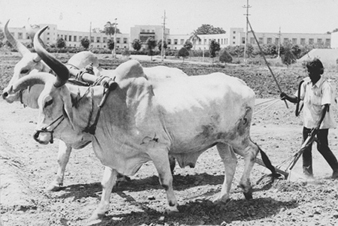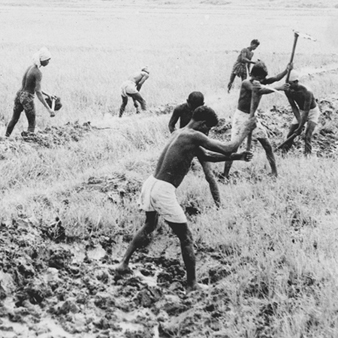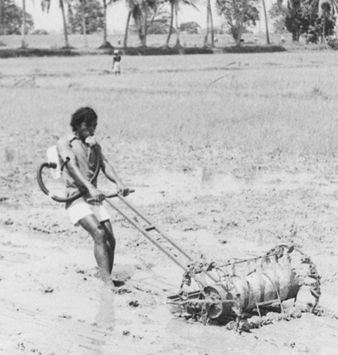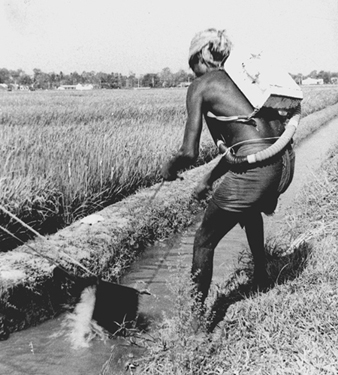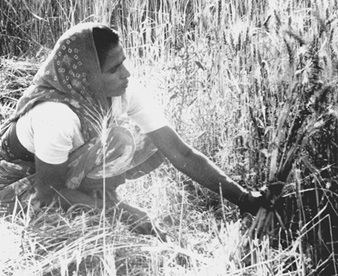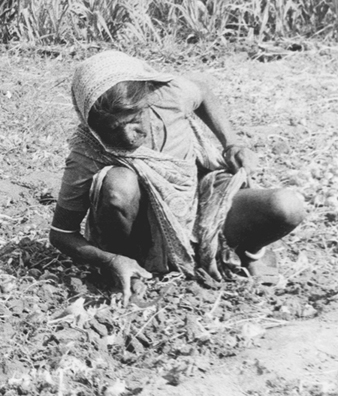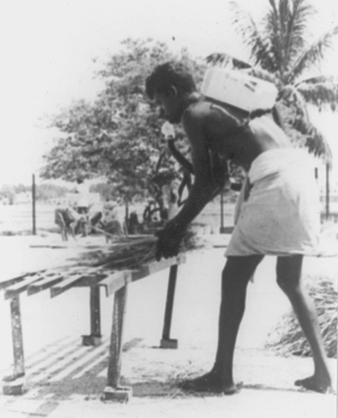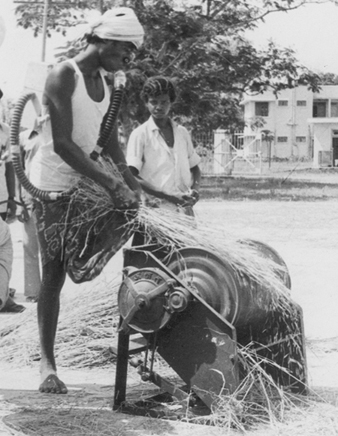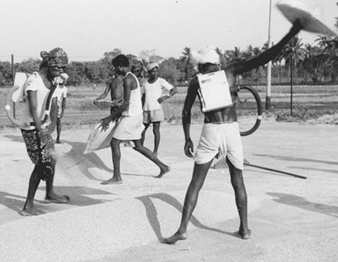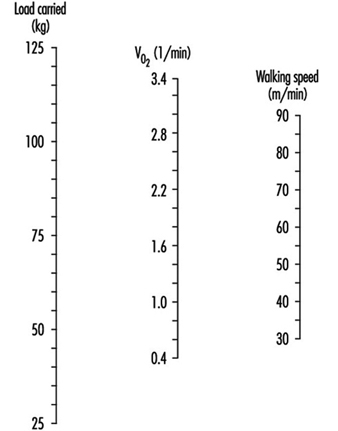Agricultural methods and practices vary across national boundaries:
- industrial agriculture—industrialized countries of the West (temperate climate) and specialized sectors of the tropical countries
- green revolution agriculture—well endowed areas in the tropics, primarily irrigated plains and deltas of Asia, Latin America and North Africa
- resource-poor agriculture—hinterlands, dry lands, forests, mountains and hills, near deserts and swamps. About 1 billion people in Asia, 300 million in sub-Saharan Africa and 100 million in Latin America are dependent on this form of agriculture. Women comprise a large proportion of subsistence farmers—nearly 80% of the food for sub-Saharan Africa, 50 to 60% of Asia’s food, 46% of the Caribbean’s food, 31% of North Africa and the Middle East’s food and 30% of Latin America’s food is produced by women (Dankelman and Davidson 1988).
With distinct agro-climatic features, the farm crops are grouped as follows:
- Field crops (cereals, oilseeds, fibre, sugar and fodder crops) are rain-fed or cultivated through controlled irrigation.
- Upland and semi-upland cultivation (wheat, groundnuts, cotton and so on) are practised where irrigation or rain water is not abundantly available.
- Wetland cultivation (rice crops) is practised where the land is ploughed and puddled with 5 to 6 cm of standing water and seedlings are transplanted.
- Horticulture crops are fruit, vegetable and flower crops.
- Plantation or perennial crops include coconut, rubber, coffee, tea and so on.
- Pastures are anything nature grows without human intervention.
Farming Operations, Hand Tools and Machinery
Farming in the tropical countries is labour intensive. The ratio of rural population to arable land in Asia is twice as great as in Africa and three times that of Latin America. It is estimated that human effort provides more than 70% of the energy required for crop production tasks (FAO 1987). Improvement in the existing tools, equipment and methods of work has significant effects in minimizing human strain and fatigue and increasing farm productivity. For field crops, farm activities may be categorized based on the physiological demand of work with reference to an individual’s maximal working capacity (see table 1).
Table 1. Categorization of farm activities
|
Work severity |
Farm operations |
|||
|
Seed bed preparation |
Sowing |
Weeding and intercultivation |
Harvesting |
|
|
Light work |
Laddering (two workers) |
Broadcasting seeds/fertilizer, scaring birds, ridging |
Fertilizer broadcasting |
Grain cleaning, grading, spreading vegetables (squatting), pounding grain (helper), winnowing (sitting) |
|
Moderately heavy work |
Walking behind animal-drawn implement, levelling soil surface with wooden rake, laddering (one worker), digging soil with spade, bush cutting |
Manual uprooting of seedlings (squatting and bent posture), transplanting seedlings (bent posture), walking on a puddled field |
Manual weeding with sickle and hand hoe (squatting and bent posture), channel irrigation, knapsack spraying of pesticides, weeder operation in wet and dry soil |
Cutting crops, harvesting paddy, wheat (squatting and bent posture), plucking vegetables, manual winnowing (sitting and standing), cutting sugarcane, pedal-thresher helper, carrying load (20-35 kg) |
|
Heavy work |
Ploughing, water lifting (swing busket), hoeing dry soil, bund trimming wet soil, spade work, disc harrowing |
Weeder operation in dry soil |
Grain threshing by beating, pounding grain |
|
|
Extremely heavy work |
Bund trimming dry soil |
Germinating seeder operation in puddled field |
Pedal threshing, carrying load on head or yoke (60-80 kg) |
|
Source: Based on data from Nag, Sebastian and Marlankar 1980; Nag and Chatterjee 1981.
Seed-bed preparation
A suitable seed-bed is one that is mellow yet compact and free from vegetation that would interfere with seeding. Seed-bed preparation involves use of different types of hand tools, shallow chisel desi or a mould board plough pulled by draft animals (figure 1) or tractor implements for ploughing, harrowing and so on. About 0.4 hectare (ha) of land can be tilled by a bullock-drawn plough in a day, and a pair of bullocks can provide power to the extent of 1 horsepower (hp).
Figure 1. Bullock-drawn shallow chisel desi plough
In using animal-drawn equipment, the worker acts as a controller of animals and guides the implement with a handle. In most cases, the operator walks behind the implement or sits on the equipment (e.g., disc harrows and puddlers). The operation of animal-drawn implements involves considerable human energy expenditure. For a 15 cm plough, a person may walk about 67 km to cover a 1-hectare area. At a walking speed of 1.5 km/h, the human energy expenditure amounts to 21 kJ/min (about 5.6 × 104 kJ per ha). A handle on implements that is too long or too short results in physical discomfort. Gite (1991) and Gite and Yadav (1990) suggested that the optimum handle height of an implement may be adjusted between 64 and 84 cm (1.0 to 1.2 times the metacarpal III height of the operator).
Hand tools (spade, shovel, hoe and so on) are used for digging and loosening the soil. To minimize drudgery in shovelling work, Freivalds (1984) deduced the optimum rate of work (i.e., shovelling rate) (18 to 21 scoops/minute), shovel load (5 to 7 kg for 15 to 20 scoops/minute, and 8 kg for 6 to 8 scoops/minute), throw distance (1.2 m) and throw height (1 to 1.3 m). Recommendations also include a shovel lift angle of about 32°, a long tool handle, a large, square-pointed blade for shovelling, a round-pointed blade for digging and hollow back construction to reduce shovel weight.
Nag and Pradhan (1992) suggested low-lift and high-lift hoeing tasks (see figure 2), based on physiological and biomechanical studies. As a general guide, the method of work and the hoe design are the deciding factors in performance efficiency of hoeing tasks (Pradhan et al. 1986). The mode of striking the blade to the ground determines the angle at which it penetrates the soil. For low-lift work, the work output was optimized at 53 strokes/ minute, with a land area dug of 1.34 m2/minute, and a work-rest ratio of 10:7. For high-lift work, the optimal conditions were 21 strokes per minute and 0.33 m2/minute of land dug. The shape of the blade—rectangular, trapezoidal, triangular or circular—depends upon the purpose and preference of the local users. For different modes of hoeing, the recommended design dimensions are: weight 2 kg, angle between blade and handle 65 to 70° , handle length 70 to 75 cm, blade length 25 to 30 cm, blade width 22 to 24 cm and handle diameter 3 to 4 cm.
Figure 2. Hoeing tasks in bund trimming in paddy field
Pranab Kumar Nag
Sowing/planting and fertilizer application
The sowing of seeds and planting of seedlings involve the use of planters, seeders, drills and the manual broadcasting of seeds. About 8% of total person-hours are required for broadcasting of seeds and uprooting and transplanting of seedlings.
- In the broadcasting of seeds/fertilizer by hand, manually operated broadcasters allow uniform distribution with minimum drudgery.
- Seeding behind a plough consists of sowing of seeds in a furrow opened by a wooden plough.
- In drilling, seeds are placed in the soil by a seed drill or seed-cum-fertilizer drill. The push/pull force required for a worker to operate the drill (manual or animal-drawn units mounted on wheels) is an important design consideration.
- Dibbling is the placing of seeds by hand or with a small implement (a dibbler), at an average spacing of 15 x 15 cm or 25 x 25 cm. Abrasion of fingers and bodily discomfort due to bent and squat postures are common complaints.
- In planting, sugar cane sets are planted at 30 cm length in a furrow; potato seed tubers are planted flat and ridges are made.
- About 1/3 of the world’s rice is grown by the transplanting system. This is also done for tobacco and some vegetable crops. Usually, germinating seeds are broadcasted densely on a puddled field. The seedlings are uprooted and transplanted to a puddled field by hand or with manual or power-operated transplanters. The operator of a manually operated transplanter walks behind the unit to operate the handle mechanism to pick and transplant the seedlings.
For manual transplanting, the workers are required to be immersed knee deep in mud. The squatting posture used for planting on dry land, with one or two legs flexed at the knee, cannot be adopted in a watered field. About 85 person-hours are required to transplant seedlings for each hectare of land. The awkward posture and static load exert strain on the cardiovascular system and cause low-back pain (Nag and Dutt 1980). Manually operated seeders produce higher work output (i.e., a seeder is about eight times more efficient than transplanting by hand). However, maintaining the balance of the machine (see figure 3) in a puddled field requires about 2.5 times more energy than manual transplanting.
Figure 3. Operating an improved germinated seeder
Paranab Kumar Nag
Plant protection
Fertilizer, pesticide, herbicide and other chemical applicators are operated by pressure through nozzles or by centrifugal force. Large-scale spraying is based on the hydraulic nozzle spray atomizer, either manually operated or using tractor-mounted equipment. Knapsack sprayers are scaled-down models of vehicle-mounted sprayers (Bull 1982).
- A compression knapsack sprayer consists of a tank, a pump and a rod with nozzle and hose.
- A lever-operated knapsack sprayer (10 to 20 l) has an operating lever.
- A power knapsack sprayer consists of a chemical tank of about 10-litre capacity and an air-cooled engine of 1 to 3 hp. The sprayer and engine unit is mounted on a frame and carried on the operator’s back.
- A hand-operated bucket sprayer and foot-operated sprayer require two persons for operating the pump and spraying. A rocking sprayer is operated by the rocking (forward and backward) movement of the handle lever.
When carried on the shoulder for prolonged periods, the vibrations of knapsack sprayers/chemical applicators have detrimental effects on the human body. Spraying using a knapsack sprayer results in potential skin exposure (the legs experience 61% of the total contamination, the hands 33%, the torso 3%, the head 2%, and the arms 1%) (Bonsall 1985). Personal protective clothing (including gloves and boots) can reduce the dermal contamination of pesticides (Forget 1991, 1992). The work is quite strenuous, due to carrying of the load on the back as well as continuous operation of the sprayer handle (20 to 30 strokes/minute); in addition, there is the thermoregulatory load due to protective garments. The weight and height of the sprayer, shape of sprayer tank, mounting system and force required to operate the pump are important ergonomic aspects.
Irrigation
Irrigation is a prerequisite for intensive cropping in arid and semi-arid regions. Since time immemorial, various indigenous devices have been used for lifting water. Lifting water by different manual methods is physically strenuous. In spite of the availability of water pump sets (electrical or engine powered), manually operated devices are widely used (e.g., swing baskets, counterpoise water lifts, water wheels, chain and washer pumps, reciprocating pumps).
- A swing basket is used for lifting water from an irrigation channel (see figure 4). The capacity of the basket is about 4 to 6 l and the frequency of operation is about 15 to 20 swings/minute. Two operators work at right angles to the direction of basket motion. The work demands heavy physical activity, with adoption of awkward body movements and posture.
- A counterpoise water lift consists of a container attached to the end of a horizontal lever which is supported on a vertical pole. The worker exerts force on the counterweight to operate the device.
- Reciprocating pumps (piston-cylinder type hand pumps) are operated either by hand in reciprocating mode or by pedalling in rotary mode.
Figure 4. Lifting water from irrigation channel using a swing basket
Pranab Kumar Nag
Weeding and intercultivation
Undesirable plants and weeds cause losses by impairing crop yields and quality, harbouring plant pests and increasing irrigation cost. Reduction in yield varies from 10 to 60% depending upon the thickness of growth and the kind of weeds. About 15% of human labour is spent in removing weeds during the cultivating season. Women typically comprise a large portion of the workforce engaged in weeding. In a typical situation, a worker spends about 190 to 220 hours weeding one hectare of land by hand or hand hoe. Spades are also used for weeding and intercultivation.
Of several methods (e.g., mechanical, chemical, biological, cultural), mechanical weeding, either by pulling out the weeds by hand or with hand tools like the hand hoe and simple weeders, is useful in both dry and wet land (Nag and Dutt 1979; Gite and Yadav 1990). In dry land, the workers squat on the ground with one or two legs flexed at the knee and remove weeds using a sickle or hand hoe. In watered land, the workers adopt a bent forward stooping posture to remove weeds manually or with the help of weeders.
The physiological demand in using weeders (e.g., blade and rake, projection finger, double sweep type weeders) is relatively higher than in manual weeding. However, the efficiency of work in terms of area covered is significantly better with the weeders than with manual weeding. The energy demand in manual weeding jobs is only about 27% of one’s working capacity, whereas for different weeders, the energy demand goes up to 56%. However, the strain is relatively less in the case of wheel hoe-type weeders, with which it takes about 110 to 140 person-hours to cover one hectare. A wheel hoe-type weeder (push/pull) consists of one or two wheels, a blade, a frame and a handle. A force (push or pull) of about 5 to 20 kilograms of force (1 kgf = 9.81 Newtons) is required, with a frequency of about 20 to 40 strokes per minute. The technical specifications of the wheel hoe-type weeders, however, need to be standardized for better operation.
Harvesting
In rice and wheat crops, harvesting requires 8 to 10% of the total person-hours used in crop production. Despite rapid mechanization in harvesting, large-scale dependence on manual methods (see figure 5) will continue for years to come. Hand tools (sickle, scythe and so on) are used in manual harvesting. The scythe is commonly used in some parts of the world, because of its large area of coverage. However, it requires more energy than harvesting with a sickle.
Figure 5. Harvesting wheat crop using a sickle
Pranab Kumar Nag
The popularity of the sickle is due to its simplicity in construction and operation. A sickle is a curved blade, with a smooth or serrated edge, attached to a wooden handle. Sickle design varies from region to region, and there is a difference in cardiorespiratory load with different types of sickles. The output varies from 110 to 165 m2/hour, values corresponding to 90 and 60 person-hours per hectare of land. Awkward work postures may lead to long-term clinical complications relating to the back and to the joints of the limbs. Harvesting in a bent posture has the advantage of mobility on both dry and wet land, and it is about 16% faster than squatting; however, a bent posture is 18% more energy demanding than squatting (Nag et al. 1988).
Harvesting accidents, lacerations and incised wounds are common in paddy, wheat and cane sugar fields. The hand tools are primarily designed for right-handed persons, but are often used by left-handed users, who are unaware of the possible safety implications. The important factors in a sickle design are the blade geometry, blade serration, handle shape and size. Based on an ergonomics study, suggested design dimensions of a sickle are: weight, 200 g; total length, 33 cm; handle length, 11 cm; handle diameter, 3 cm; radius of blade curvature, 15 cm; blade concavity, 5 cm. For a serrated sickle: tooth pitch, 0.2 cm; tooth angle, 60°; and ratio of the length of cutting surface to chord length, 1.2. Since the workers perform activities under extreme climatic conditions, health and safety issues are critically important in tropical farming. The cardiorespiratory strain accumulates over long hours of work. Extreme climatic conditions and heat disorders place added stress on the worker and diminish working capacity.
Harvesting machines include mowers, choppers, balers and so on. Power-operated or animal-drawn reapers are also used for harvesting field crops. Combine harvesters (self-propelled or tractor operated) are useful where intensive cultivation is practised and the labour shortage is acute.
Harvesting of sorghum is done by cutting the ear-head and then cutting the plant, or vice versa. The cotton crop is collected in 3 to 5 pickings by hand as the ball matures. Harvesting of potatoes and sugar beets is done manually (see figure 6) or by using a blade harrow or digger, which may be animal or tractor powered. In the case of groundnuts, the vines are either pulled manually or removed using diggers, and the pods separated.
Figure 6. Manual harvesting of potatoes with a hand hoe
Threshing
Threshing includes separation of grains from the earheads. Age-old manual methods of threshing of grain from the paddy pinnacle are: rubbing the earheads with one’s feet, beating of the harvested crop on a plank, animal treading and so on. Threshing is classified as a moderately heavy task (Nag and Dutt 1980). In manual threshing by beating, (see figure 7) one separates about 1.6 to 1.8 kg of grain and 1.8 to 2.1 kg of straw per minute from medium sized paddy/wheat plants.
Figure 7. Threshing paddy pinnacle by beating
Pranab Kumar Nag
Mechanical threshers carry out threshing and winnowing operations simultaneously. The pedal thresher (oscillating or rotary mode) increases the output to 2.3 to 2.6 kg of grain (paddy/wheat) and 3.1 to 3.6 kg of straw per min. Pedal threshing (see figure 8) is a more strenuous activity than manual threshing by beating. The pedalling and holding of paddy plants on the rolling drum result in high muscular strains. Ergonomic improvements in the pedal thresher may allow a rhythmic pattern of leg work in alternate sitting and standing postures and minimize postural strains. The optimal momentum of the thresher may be reached at about 8 kg weight of the rolling drum.
Figure 8. A pedal thresher in operation
Pranab Krumar Nag
Power threshers are gradually being introduced in green revolution areas. Essentially they consist of a prime mover, a threshing unit, a winnowing unit, a feeding unit and a outlet for clean grain. Self-propelled combines are a combination of a harvester and a thresher unit for grain crops.
Fatal accidents have been reported in grain threshing using power threshers and fodder cutters. The incidence of moderate to severe thresher injuries was 13.1 per thousand threshers (Mohan and Patel 1992). Hands and feet can be injured by the rotor. The position of the feeding chute can result in awkward postures when feeding the crop into the thresher. The belt powering the thresher is also a common cause of injuries. With fodder cutters, the operators can sustain injury while feeding the fodder into the moving blades. Children sustain injury when playing with the machines.
The workers often stand on unstable platforms. In the event of a jerk or loss of balance, the torso weight pushes the hands into the threshing drum/fodder cutter. The thresher must be designed so that the feeding chute is at elbow level and the operators stand on a stable platform. The design of the fodder cutter may be improved for safety as follows (Mohan and Patel 1992):
- a warning roller placed on the chute before the feed rollers
- a locking pin to fix the flywheel when the cutter is not in use
- gear cover and blade guards to push limbs away and prevent clothes from getting entangled.
For threshing groundnuts, the traditional practice is to hold the plants by one hand and strike them against a rod or grill. For threshing maize, tubular maize shellers are used. The worker holds the equipment in his or her palm and inserts and rotates cobs through the equipment to separate the maize grains from the cobs. Output with this equipment is about 25 kg/hour. Hand-operated rotary type maize shellers have higher work output, about 50 to 120 kg/hour. The length of the handle, the force required to operate it and the speed of operation are the important considerations in hand-operated rotary maize shellers.
Winnowing
Winnowing is a process to separate grains from chaff by blowing air, using a hand fan or a pedal- or motor-driven fan. In manual methods (see figure 9), the whole content is thrown up in the air, and the grain and chaff get separated out by differential momentum. A mechanical winnower may, with considerable human exertion, be hand or pedal operated.
Figure 9. Manual winnowing
Pranab Kumar Nag
Other post-harvest operations include cleaning and grading of grains, shelling, decortication, hulling, peeling, slicing, fibre extraction and so on. Different types of manually operated equipment are used in post-harvest operations (e.g., potato peelers and slicers, coconut dehuskers). Decortication involves breaking of shells and removal of seeds (e.g., groundnuts, castor beans). A groundnut decorticator separates kernels from pods. Manual decortication has a very low output (about 2 kg of pod shelling per person-hour). Workers complain of bodily discomfort due to the continuous sitting or squatting posture. Oscillating or rotary-mode decorticators have an output of about 40 to 60 kg of pods per hour. Shelling and hulling refer to separation of seed coat or husk from the inner portion of the grain (e.g., paddy, soybean). Traditional rice hullers are manually (hand or foot) operated and are widely used in rural Asia. The maximum force which can be exerted by hand or foot determines the size and other characteristics of the device. Nowadays, motorized rice mills are used for hulling. In some grains, such as pigeonpea, the seed coat or husk is tightly attached. Removal of the husk in such cases is called dehusking.
For different hand tools and manually operated implements, the grip size and the force exerted on the handles are important considerations. In the case of shears, the force which can be applied by two hands is important. Although most injuries related to hand tools are classified as minor, their consequences are often painful and disabling because of delayed treatment. Design changes in hand tools should be limited to those that can be easily fabricated by village artisans. Safety aspects need to be given due consideration in powered equipment. Safety shoes and gloves available at present are far too expensive and are not suitable for farmers in the tropics.
Manual material-handling tasks
Most agricultural activities involve manual material-handling tasks (e.g., lifting, lowering, pulling, pushing and carrying of heavy loads), resulting in musculoskeletal strains, falls, spinal injuries and so on. The fall injury rate increases dramatically when the fall height is more than 2 m; impact forces are reduced manyfold if the victim falls on soft earth, hay or sand.
In rural areas, loads weighing 50 to 100 kg might be carried several miles on a daily basis (Sen and Nag 1975). In some countries, women and children have to fetch water in large quantities from a distance. These arduous tasks need to be minimized to the extent possible. Different methods of water carriage involve carrying on the head, on the hip, on the back and on the shoulder. These have been associated with a variety of biomechanical effects and spinal disorders (Dufaut 1988). Attempts have been made to improve shoulder load-carrying techniques, designs of wheelbarrows and so on. Load transportation using transverse yoke and head load are more efficient than the frontal yoke. The load optimization that can be carried by men may be obtained from the nomogram shown (figure 10). The nomogram is based on a multiple regression drawn between oxygen demand (the independent variable) and load carried and walking speed (the dependent variables). One may put a scale on the graph across the variables to identify the result. Two variables must be known to find the third. For example, with an oxygen demand of 1.4 l/min (approximate equivalent of 50% of one’s maximum working capacity) and walking speed of 30 m/min, the optimum load would be about 65 kg.
Figure 10. A nomogram to optimize load to be carried on head/yoke, with reference to walking speed and oxygen demand of work.
In view of the diversity of farm activities, certain organizational measures towards redesigning of tools and machinery, methods of work, installation of safety guards on machinery, optimization of human exposure to adverse work environment and so on may significantly improve conditions of work for farming populations (Christiani 1990). Extensive ergonomic research on farm methods and practices, tools and equipment may generate a great deal of knowledge for the betterment of health, safety and productivity of billions of agricultural workers. This being the world’s largest industry, the primitive image of the sector, particularly the resource-poor tropical agriculture, could be transformed as task-oriented. Thus rural workers can undergo systematic training on the hazards of jobs, and safe operational procedures can be developed.

